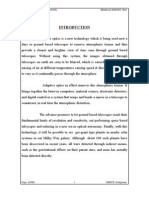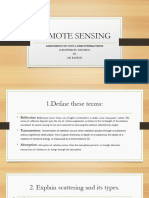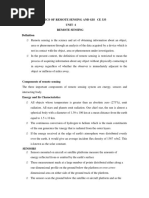2006 Physics HSC
2006 Physics HSC
Uploaded by
jazzydeecCopyright:
Available Formats
2006 Physics HSC
2006 Physics HSC
Uploaded by
jazzydeecOriginal Description:
Original Title
Copyright
Available Formats
Share this document
Did you find this document useful?
Is this content inappropriate?
Copyright:
Available Formats
2006 Physics HSC
2006 Physics HSC
Uploaded by
jazzydeecCopyright:
Available Formats
Section One: Earth-based observations
(a) Discuss Galileos use of the telescope to identify features of the Moon. Galileo did not invent the telescope, but he did refine its design. He built refracting telescopes which produced an upright image, and masked out the edge of the front lens of his telescope to overcome spherical aberration. Galileo was the first to use a telescope to make systematic astronomical observations of the features of the Moon as well as observations of the phases of Venus, the moons of Jupiter, the rings of Saturn and sunspots. In particular Galileo made both qualitative and quantitative observations of the Moon. He observed that the Moon was rough, like the Earth, and drew sketches of vast plains (Mare) and mountains. He also made quantitative measurements of the lengths of the long shadows cast by the mountains of the Moon when they were near the edge of the shadow (called the limb) and directly facing Earth (first or last quarter). From this he was able to estimate that these mountains were at least several kilometers high. Galileos telescope was described as an instrument of the devil as it allowed him to observe properties of the moon and Jupiter which challenged the prevailing Aristotelian view, endorsed by the Church of Rome, that the heavenly bodies were perfect and unchanging and that the Earth was at the centre of the Universe. (b) Discuss why some wavebands can be more easily detected from space. Almost all our information on the cosmos comes to us in the form of electromagnetic radiation. Because the range of wavelengths is so vast, the electromagnetic spectrum is loosely divided into bands, based on wavelength and on how the radiation can be produced and detected. These bands include very short wavelength gamma rays, x-rays, ultra violet, visible, infrared through to very long wavelength radio waves. The wavelength where one band ends and another starts is to some extent blurred; for example very short wavelength ultra violet light may sometimes be considered as a soft or long wavelength x-ray. Also you may read where some bands are further divided; for example very short wavelength radio waves are commonly referred to as microwaves, whilst other subdivisions of the radio band include HF, VHF and UHF. A waveband is a part of the electromagnetic spectrum covering a specific range of wavelengths. The Earths atmosphere absorbs scatters or reflects some wavelength bands more than others. Some bands are strongly absorbed and do not reach the ground, and are best observed from outside the atmosphere. Other wavebands are absorbed little and penetrate easily to the ground where they can be observed. The highly energetic gamma rays and x-rays ionize molecules making up the atmosphere and are therefore strongly absorbed in the upper atmosphere, with very little reaching the ground. These wavebands are more easily detected by telescopes placed in orbit outside Earths atmosphere, such as COBE and Chandra X-ray telescope, than by ground-based telescopes. Some bands of ultraviolet radiation are strongly absorbed by the ozone layer of the atmosphere, while others penetrate to the ground.
(c) Identify data sources, plan , choose equipment or resources for, and perform an investigation to demonstrate why it is desirable for telescopes to have a large diameter objective lens or mirror in terms of both sensitivity and resolution. Choose two instruments of the same magnification but different objective diameters, such as: two different astronomical telescopes if available; a single telescope with the correct eyepiece to match the magnification of its finder; or two different pairs of binoculars. (Binoculars consist of two telescopes mounted side-by-side, with prisms in the light path to shorten the length of the instrument. The magnification and objective diameter (in mm) are shown as, for example, 10 x 50.) Choose an astronomical object with features that are easy to see in a small telescope, such as the Moon or Saturn. If you are working during the day, choose the most distant object you can see, such as a tree-covered hill. Make notes on the relative brightness and the relative clarity of the same object through the two instruments. If equipment is available, try to photograph the same object through the two instruments and compare the developed images. Relate any differences in brightness and clarity to the diameter of the objective lens or mirror. The atmosphere does not scatter or absorb the visible waveband very much. Consequently these wavelengths pass through the atmosphere relatively unhindered and reach the ground. This is why we have sunlight and starlight, and optical telescopes can be used effectively at ground level. Infrared wavelengths are only partially absorbed. As an alternative to the expensive procedure of placing them into space, infrared sensitive telescopes may be placed on mountain tops above the densest regions of the atmosphere. Some parts of the radio band are also absorbed to various degrees while others pass easily through the atmosphere. Radio telescopes such as the one at Parkes, NSW, were built to take advantage of this. Very long wavelength radio waves are reflected by the ionosphere. (d) Define the terms resolution and sensitivity of telescopes. The resolution (or resolving power) of a telescope is a measure of the ability of the telescope to reveal fine detail. Resolution is usually described in terms of the smallest angle of separation between two points of light, such as two stars close together in the sky, that can be seen as two distinct images. Resolution depends on the diameter of the objective lens or mirror and on the wavelength of the light. A telescope with low resolution will see closely positioned stars as fuzzy and blurred together, while a telescope with high resolution will produce sharp, distinct images. Resolution may be limited by atmospheric conditions and the quality of the optics. For most large astronomical telescopes, resolution is stated in arc second (1 arc second (1) = 1/3600 degree). The sensitivity of a telescope is a measure of the minimum intensity of light that needs to fall on the telescope to form a suitable image. Sensitivity is proportional to the area of the light collecting surface, so doubling the diameter of a telescopes objective should result in a four fold increase in sensitivity. Thus the sensitivity of a telescope is often referred to as its light gathering ability. In practice, the sensitivity of any particular instrument can also depend on other things such as the quality and age of the optics. The relative sensitivity of two
telescopes may easily be compared qualitatively by comparing the brightness of the image produced by the same object in each telescope. A telescope with greater sensitivity produces brighter images and can detect fainter stars than a lower sensitivity telescope. (e) Discuss the problems associated with ground-based astronomy in terms of resolution and absorption of radiation and atmospheric distortion. Ground-based detectors of electromagnetic radiation from space, including telescopes, sit beneath a constantly changing sea of air, water vapor, other gases and dust. Variations in temperature and pressure, and corresponding changes in refractive index, cause stars to twinkle, exhibiting rapid variations in colour and intensity. From an astronomical point of view, this atmospheric distortion causes images to shimmer and go in and out of focus, thus lowering the overall theoretical resolution of the telescope. Gamma rays, x-rays, ultraviolet, infrared and parts of the radio region of the electromagnetic spectrum are absorbed and scattered to different extents by the atmosphere. Ground-based astronomy in these wavebands is very difficult because of the low intensity of radiation reaching the ground. So much light from the violet end of the visible waveband is scattered, making the daytime sky bright blue, that optical astronomy is virtually impossible other than at night. The true colour of images is altered because at ground level the variations in absorption with wavelength mean that we are not seeing an accurate reproduction of the intensity of the spectrum. All these affects are accentuated if the object being observed is lower in the sky because the path length the light has to travel through the atmosphere is greater. The atmosphere also scatters extraneous light into the telescope from unwanted sources such as nearby houses, cars and towns. This light pollution is increasingly becoming a major problem for astronomers. (f) Outline methods by which the resolution and/or sensitivity of ground-based systems can be improved, including: adaptive optics, interferometry and active optics; One straight-forward way to reduce the atmospheric distortion and allow a telescope to operate near its theoretical resolution is to place the telescope as high in the atmosphere as possible. This means placing ground-based telescopes on high mountaintops, above the densest part of the atmosphere, above most of the moisture in the air (which blocks microwave radiation), and above most of the air currents arising from weather patterns and convection. High mountaintops also have the advantage of remoteness from human activity so light pollution is less serious. Astronomical instruments are sometimes carried aloft in high-altitude balloons or aircraft. Adaptive optics: This uses a system of electronically controlled thrusters or supports which adjust the shape or the angle of the telescope mirror to compensate for image distortion caused by the atmosphere. Sensors quickly detect atmospheric distortion which is then analyzed by a computer. Thrusters are then used to bend the flexible mirror or adjust multiple mirrors into the shape to produce the best possible image. The success of adaptive optics relies on the detection and correction taking place very quickly compared to the length of time over which the distortion lasts. Interferometry: The reason that a large diameter mirror gives a sharper image is because the reflections of the wave front at various points across the diameter add via the law of superposition in such a way as to produce a sharper image.
This suggests that it may be possible to produce a sharp image by carefully adding the wave fronts of two or more smaller telescopes separated by a large distance to give an image sharpness that is theoretically equivalent to one single larger telescope. This procedure, known as interferometry, is very effectively used with radio telescopes, where two or more telescopes in different parts of the world are linked into an array. Active optics: To increase the sensitivity of a telescope, the area of the primary mirror needs to be large. Unfortunately the larger area of a mirror, the more susceptible it is to becoming distorted and the thicker it needs to be to retain an accurate shape with changes in temperature and telescope orientation. For many years this meant that there was a fundamental limit to the largest sized telescope that could be built. However by using a thin, sometimes segmented, primary mirror and slowly monitoring the reflection of the wave front off it, it is possible to apply pressure to various parts of the primary and correct for the deforming effects. The monitoring must be done slowly enough so that changes observed in the wave front are indeed due to correctable changes in the optics and not to rapid random changes caused by uncontrollable atmospheric effects.
You might also like
- Hofstede's Cultural Dimensions Score - MyanmarDocument2 pagesHofstede's Cultural Dimensions Score - Myanmarpoiu0987100% (3)
- Braitenberg, Valentino - Vehicles (1984)Document164 pagesBraitenberg, Valentino - Vehicles (1984)Gabriel CeriniNo ratings yet
- Paul GordonDocument3 pagesPaul GordonxbxcxbxvNo ratings yet
- Theme Analysis of 'Pride and Prejudice' by Zheng JiayinDocument22 pagesTheme Analysis of 'Pride and Prejudice' by Zheng Jiayinpaperbin100% (2)
- Celestial ObjectsDocument7 pagesCelestial ObjectsPRASAD RAVICHANDRANNo ratings yet
- AstrophysicsDocument55 pagesAstrophysicsrbtlch1nNo ratings yet
- Our Understanding of Celestial Objects Depends Upon Observations Made From Earth or From Space Near EarthDocument13 pagesOur Understanding of Celestial Objects Depends Upon Observations Made From Earth or From Space Near Earthchristian-dale-lim-1450No ratings yet
- Observational Astronomy - WikipediaDocument13 pagesObservational Astronomy - WikipediaMario ReileyNo ratings yet
- Observational AstronomyDocument5 pagesObservational AstronomyVeronica GușanNo ratings yet
- Observational Techniques - STARBASEDocument1 pageObservational Techniques - STARBASEecleseastico231No ratings yet
- Solar System 9th Edition Seeds Solutions Manual DownloadDocument11 pagesSolar System 9th Edition Seeds Solutions Manual DownloadNatalie Neal100% (19)
- TelescopesDocument23 pagesTelescopesAryan SaxenaNo ratings yet
- Maulica Physics ProjectDocument17 pagesMaulica Physics ProjectmanthanmahendrajagtapNo ratings yet
- TelescopeDocument6 pagesTelescopeGermaeGonzalesNo ratings yet
- Review Paper - Performance Evaluation of Ground and Space TelescopesDocument15 pagesReview Paper - Performance Evaluation of Ground and Space Telescopespranit.shahNo ratings yet
- NljsfvdumgdgzDocument10 pagesNljsfvdumgdgzvardankhandelwal2007No ratings yet
- Kinds of Telescopes A. Optical TelescopesDocument3 pagesKinds of Telescopes A. Optical Telescopesrazee_No ratings yet
- Adaptive OpticsDocument26 pagesAdaptive OpticsPrasanth NaikNo ratings yet
- HSC Physics Astrophysics NotesDocument26 pagesHSC Physics Astrophysics NotesjackmaloufNo ratings yet
- Optical Interferometeric Case StudyDocument20 pagesOptical Interferometeric Case Studydhiraj04041998No ratings yet
- Chapter 6Document128 pagesChapter 6teacherangiebyshNo ratings yet
- Event Horizon Telescope & VlbiDocument10 pagesEvent Horizon Telescope & VlbiAkhil KumarNo ratings yet
- 14709Document47 pages14709lineyscorkinNo ratings yet
- James Webb Data NewsDocument13 pagesJames Webb Data NewsCat SteinNo ratings yet
- @IELTS_saladDocument2 pages@IELTS_saladMuniraNo ratings yet
- 14713Document47 pages14713lineyscorkinNo ratings yet
- Astronomical Spectroscopy: Jump To Navigation Jump To SearchDocument3 pagesAstronomical Spectroscopy: Jump To Navigation Jump To SearchDexterNo ratings yet
- 1.1) Galileo's Telescopes: 1) Observing The UniverseDocument9 pages1.1) Galileo's Telescopes: 1) Observing The UniverseTrungVo369No ratings yet
- Telescope 3Document1 pageTelescope 3jubair.jee17No ratings yet
- The Electromagnetic SpectrumDocument30 pagesThe Electromagnetic Spectrummaneesh_massey_1100% (1)
- Assignment - Week03Document2 pagesAssignment - Week03Amrit SharmaNo ratings yet
- English WorkDocument5 pagesEnglish WorksandroproytNo ratings yet
- 2 A Intro Astronomy LintagDocument27 pages2 A Intro Astronomy LintagRea OrtizNo ratings yet
- Adaptive OpticsDocument6 pagesAdaptive Opticsarvind rNo ratings yet
- Objectives and Handout AGE 400Document131 pagesObjectives and Handout AGE 400Mackenzie ImmanuelNo ratings yet
- What Is Remote SensingDocument14 pagesWhat Is Remote Sensingdereje olikaNo ratings yet
- unit 3 remote sensingDocument15 pagesunit 3 remote sensingKuldeep SinghNo ratings yet
- Ray Tracing (Physics)Document5 pagesRay Tracing (Physics)chuck333No ratings yet
- Assignment Gis 1Document7 pagesAssignment Gis 1Ummiey SyahirahNo ratings yet
- Стаття + глосарійDocument13 pagesСтаття + глосарійmaryna starovoitenkoNo ratings yet
- Basics of Remote Sensing and Gis Ce 333 Unit - 1 Remote SensingDocument13 pagesBasics of Remote Sensing and Gis Ce 333 Unit - 1 Remote SensingShanmuga SundaramNo ratings yet
- A Brief Introduction To Remote SensingDocument4 pagesA Brief Introduction To Remote SensingglprraNo ratings yet
- Astro 3 Final StudyguideDocument53 pagesAstro 3 Final StudyguideVincentNo ratings yet
- Astronomy 3Document4 pagesAstronomy 3John Kenneth BentirNo ratings yet
- Cosmic Distance Ladder - WikipediaDocument93 pagesCosmic Distance Ladder - WikipediaKRISH NARAYANANo ratings yet
- What Is An Astronomial Telescope EditedDocument18 pagesWhat Is An Astronomial Telescope Editedharitharajan2407No ratings yet
- Astrophysics For ScientistsDocument3 pagesAstrophysics For Scientistskumara10910No ratings yet
- Uses of Astronomical Telesope: MagnificationDocument5 pagesUses of Astronomical Telesope: Magnificationharitharajan2407No ratings yet
- Sample 1Document12 pagesSample 1KhamNo ratings yet
- main te;escopeDocument13 pagesmain te;escopeay8785701No ratings yet
- Adaptive Optics in Astronomy V 3 ADocument27 pagesAdaptive Optics in Astronomy V 3 AWafer WafNo ratings yet
- Kagabie TinDocument6 pagesKagabie TinChristian PatingaNo ratings yet
- The Electromagnetic SpectrumDocument8 pagesThe Electromagnetic SpectrumImam A. RamadhanNo ratings yet
- Familiarization of Observation Instruments Use in AstronomyDocument53 pagesFamiliarization of Observation Instruments Use in AstronomyArunava Das AdhikaryNo ratings yet
- Koller-Thompson LightPollution 20201026Document8 pagesKoller-Thompson LightPollution 20201026Mahbub AlahiNo ratings yet
- LN - 10 - 55 - Lecture On Satellite MeteorologyDocument46 pagesLN - 10 - 55 - Lecture On Satellite MeteorologyASNMURTYNo ratings yet
- Adaptive Optics in Ground Based TelescopesDocument24 pagesAdaptive Optics in Ground Based TelescopesBibinMathewNo ratings yet
- Cosmic Distance LadderDocument18 pagesCosmic Distance LadderGregor SamsaNo ratings yet
- TelescopesDocument43 pagesTelescopesDhipin DevarajNo ratings yet
- Light and TelescopesDocument51 pagesLight and TelescopesKentNo ratings yet
- Astronomy 101: The Introductory Guide to Enthusiastic StargazersFrom EverandAstronomy 101: The Introductory Guide to Enthusiastic StargazersNo ratings yet
- Knowledge in a Nutshell: Astrophysics: The complete guide to astrophysics, including galaxies, dark matter and relativityFrom EverandKnowledge in a Nutshell: Astrophysics: The complete guide to astrophysics, including galaxies, dark matter and relativityNo ratings yet
- Qi Men Dun Jia: Yang 1Document5 pagesQi Men Dun Jia: Yang 1Shushuma BlissNo ratings yet
- Post Advertising Daniel SolanaDocument46 pagesPost Advertising Daniel SolanaIzaskun Fernandez GarciaNo ratings yet
- Understanding The Process of Community Capacity BuildingDocument16 pagesUnderstanding The Process of Community Capacity Buildingsubhan16No ratings yet
- A Day Without ConflictsDocument2 pagesA Day Without ConflictsVlad MoldovanuNo ratings yet
- The Narcissistic Self: Background, An Extended Agency Model, and Ongoing ControversiesDocument24 pagesThe Narcissistic Self: Background, An Extended Agency Model, and Ongoing Controversiessimpeeee100% (1)
- Effects of Social SkillDocument9 pagesEffects of Social SkillFira NurulizaNo ratings yet
- Influencing Factors On The Visualisation of Archaeological UncertaintyDocument7 pagesInfluencing Factors On The Visualisation of Archaeological UncertaintyMaria SifNo ratings yet
- Contracts Sec 25Document22 pagesContracts Sec 25Nikhil DeoNo ratings yet
- Willis TBLDocument6 pagesWillis TBL123sheonaNo ratings yet
- Scientific ArticlesDocument3 pagesScientific ArticlesIndri WidyartiNo ratings yet
- Funny Latin PhrasesDocument4 pagesFunny Latin PhrasesHugh Fox IIINo ratings yet
- PHL203Document127 pagesPHL203awoniyiracheal4No ratings yet
- Robert Weimann, Douglas Bruster Shakespeare and The Power of Performance - Stage and Page in The Elizabethan Theatre 2008Document278 pagesRobert Weimann, Douglas Bruster Shakespeare and The Power of Performance - Stage and Page in The Elizabethan Theatre 2008Panos MavNo ratings yet
- There Are Some Factors That Affect The Human BehaviorDocument2 pagesThere Are Some Factors That Affect The Human BehaviorChristine Joy AguhoNo ratings yet
- ExpertProficiency WLDocument37 pagesExpertProficiency WLAnonymous QkFRr4g0% (1)
- Quantum Mechanics II Solution Sheet 7Document4 pagesQuantum Mechanics II Solution Sheet 7Joyee BasuNo ratings yet
- MCQ in Social Science Part 14 Licensure Exam For Teachers 2022Document20 pagesMCQ in Social Science Part 14 Licensure Exam For Teachers 2022ravenNo ratings yet
- Impact of Western CultureDocument27 pagesImpact of Western CultureShruti VikramNo ratings yet
- SHM 2Document23 pagesSHM 2Navin RaiNo ratings yet
- The Effects of Skipping Meals On Academic Performance of Grade 8 Students of Batangas Province Science High School During The School Years 2019 2020 Group 6Document8 pagesThe Effects of Skipping Meals On Academic Performance of Grade 8 Students of Batangas Province Science High School During The School Years 2019 2020 Group 6Nicole Rae delos ReyesNo ratings yet
- Emergence of Ideas About AtomDocument27 pagesEmergence of Ideas About AtomJosh SchultzNo ratings yet
- Tesco 1: Roles of Performance Evaluation On Workplace Transformation in Tesco ResearchDocument23 pagesTesco 1: Roles of Performance Evaluation On Workplace Transformation in Tesco ResearchstephenNo ratings yet
- Real Analysis MTWR 6:00 - 7:30PM: SYLLABUS: The Real Number System, Sequences in RDocument2 pagesReal Analysis MTWR 6:00 - 7:30PM: SYLLABUS: The Real Number System, Sequences in RMarcos ShepardNo ratings yet
- Master King Ashoka InputDocument3 pagesMaster King Ashoka Inputapi-194762500No ratings yet
- Campbell Green Cities, Growing Cities, Just Cities PDFDocument17 pagesCampbell Green Cities, Growing Cities, Just Cities PDFΜατίνα ΦλώρουNo ratings yet
- PID ExercisesDocument6 pagesPID ExercisesadrianordsNo ratings yet

























































































